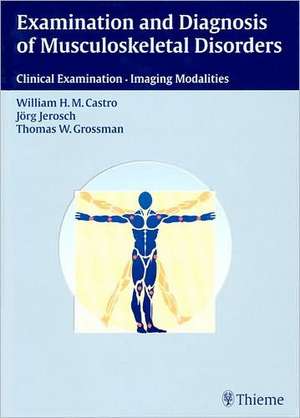Examination and Diagnosis of Musculoskeletal Disorders: History - Physical Examination - Imaging Techniques - Arthroscopy
Autor William H. M. Castro, Joerg Jerosch, Thomas W. Grossman, Jr.en Limba Engleză Hardback – 31 oct 2000
The first book ever published to combine the full range of clinical examination techniques with standard radiological imaging studies of the musculoskeletal system, this is a key clinical tool for all orthopedic residents and specialists. You will find dozens of representative imaging studies (including arthrograms, ultrasonography and MRI) integrated with physical examination tests -- offering a truly unique approach to reaching an accurate diagnosis.
Special features include:
Special features include:
- Tips for performing a standard physical examination in different areas of the body
- Directions for patient positioning during radiographic studies to obtain optimal results
- How to select the best test to confirm a diagnosis in the extremities, spine or pelvis
- Specific technical guidelines for performing key diagnostic imaging tests
Preț: 863.91 lei
Preț vechi: 909.37 lei
-5% Nou
Puncte Express: 1296
Preț estimativ în valută:
165.31€ • 173.03$ • 137.59£
165.31€ • 173.03$ • 137.59£
Carte indisponibilă temporar
Doresc să fiu notificat când acest titlu va fi disponibil:
Se trimite...
Preluare comenzi: 021 569.72.76
Specificații
ISBN-13: 9781588900326
ISBN-10: 1588900320
Pagini: 464
Ilustrații: 1166
Dimensiuni: 191 x 267 x 28 mm
Greutate: 1.75 kg
Ediția:1st edition
Editura: Thieme
Colecția Thieme
ISBN-10: 1588900320
Pagini: 464
Ilustrații: 1166
Dimensiuni: 191 x 267 x 28 mm
Greutate: 1.75 kg
Ediția:1st edition
Editura: Thieme
Colecția Thieme
Recenzii
This easy-to-read book is an encyclopedia of information presented in the length of a good novel. The authors have compiled an impressive collection of information on musculoskeletal history-taking, physical examination, and the ordering and interpretation of images produced by the many modalities that are currently available. Both traumatic and nontraumatic conditions are discussed. The illustrations include clinical photographs, line drawings, and superb reproductions of all types of images. The layout and the style of writing make the text very reader-friendly.Two of the primary authors, Dr. Castro and Dr. Jerosch, are from Germany, and the third, Dr. Grossman, is from the United States. There are eleven other contributing authors; however, the style of the book is uniform throughout, and the translation is as good as any original English-language work.The book's nine chapters are organized by anatomic region (the shoulder, knee, pelvis, and so on). Each chapter contains sections on clinical examination, including patient history; plain radiography, including special views; and other imaging modalities. The sections on radiography and other imaging modalities provide very clear examples of normal and abnormal findings. At the end of each chapter is a moderate list of references, approximately one-half of which are from the European literature; however, the book is so complete that use of the references is rarely necessary. The standardized format used for each chapter makes this an easy and quick reference source.Each chapter covers plain radiography, computerized axial tomography (including three-dimensional reconstruction), magnetic resonance imaging, arthrography, and nuclear medicine studies. There is an emphasis on the appropriate imaging modality for each disorder. For example, a considerable amount of discussion is devoted to the use of magnetic resonance imaging for the evaluation of chronic shoulder problems; this section includes good illustrations of pathologic conditions, with excellent labeling.The sections on clinical examination begin with a discussion of basic concepts and proceed to more specific clinical tests. For example, in the knee chapter, fundamental tests such as measurement of the Q angle are described, followed by descriptions of several sophisticated tests for ligamentous stability.Although some pediatric conditions are mentioned, the primary focus is on adult injuries and disorders. Similarly, there is no discussion of treatment, outcomes, clinical pathology, or laboratory tests; the book concentrates on diagnosis only.In summary, this is a superb book for both residents and practicing orthopaedic surgeons, and it more than meets the goal of imparting relevant diagnostic material. It is unusual to find a work in which so much up-to-date information is so well presented. The text can serve as either a quick reference or a detailed review of clinical examination features and imaging findings associated with particular musculoskeletal disorders. I recommend it without hesitation.--The Journal of Bone and Joint Surgery, Inc.Simple easy to use schematics illustrate the text quite nicely and really enhance its short and to the point descriptions...valuable information...provides a systemic approach for the physical examination of a patient, as well as a review of radiological anatomy --Journal of Musculoskeletal PainAn excellent reference book...abundantly illustrated throughout...a well-written, exhaustive text and should be available in all orthopaedic departments and libraries as an essential reference...recommended. --European Journal of Orthopaedic Surgery and TraumatologyOffers direct and understandable descriptions of clinical techniques...[images] are impressively reproduced....a worthwhile addition to the bookshelf of anyone involved in a career in musculoskeletal practice. --International Journal of the Care of the Injured
Notă biografică
Adjunct Assistant Professor of Surgery, Uniformed Services University of the Health Sciences, Bethesda, MD
Textul de pe ultima copertă
The first book ever published to combine the full range of clinical examination techniques with standard radiological imaging studies of the musculoskeletal system, this is a key clinical tool for all orthopedic residents and specialists. You will find dozens of representative imaging studies (including arthrograms, ultrasonography and MRI) integrated with physical examination tests -- offering a truly unique approach to reaching an accurate diagnosis.
Special features include:
Special features include:
- Tips for performing a standard physical examination in different areas of the body
- Directions for patient positioning during radiographic studies to obtain optimal results
- How to select the best test to confirm a diagnosis in the extremities, spine or pelvis
- Specific technical guidelines for performing key diagnostic imaging tests
